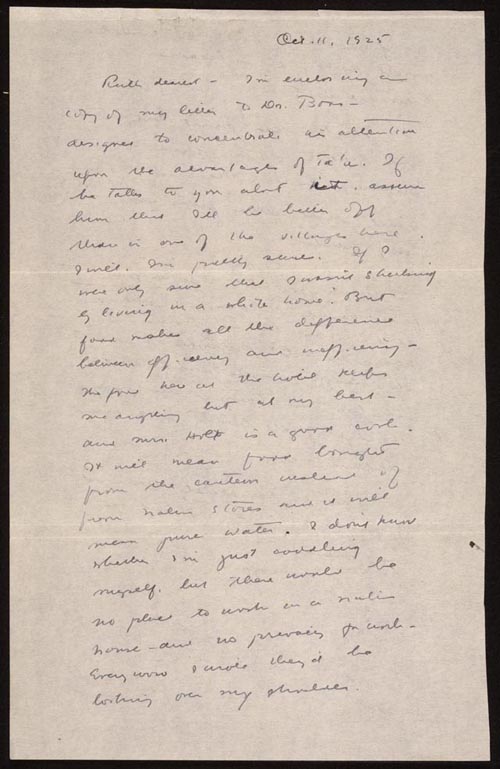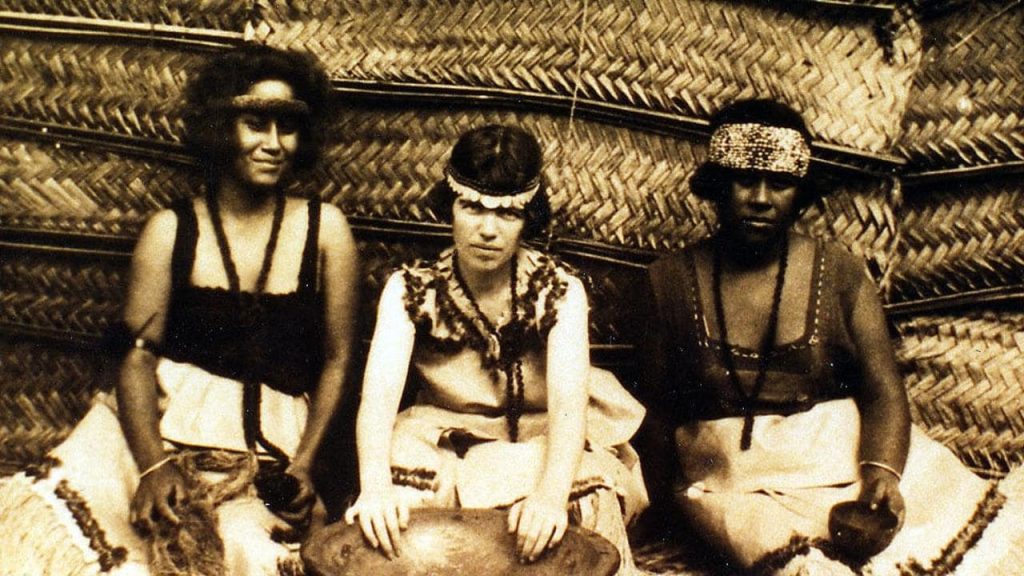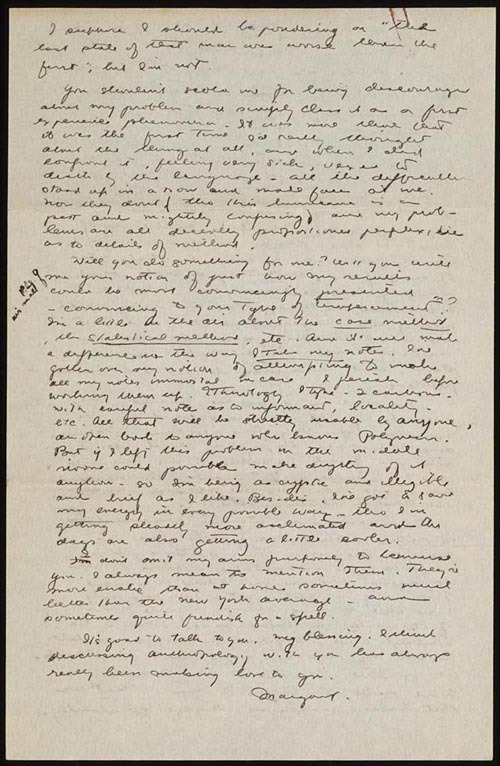
LOVE LETTER: MARGARET MEAD AND RUTH BENEDICT

Margaret Mead endures as the world’s best-known and most influential cultural anthropologist, who not only popularized anthropology itself but also laid the foundation for the sexual revolution of the 1960s with her studies of attitudes towards sex. In addition to broadening cultural conventions through her work, she also embodied the revolution in her personal life. Married three times to men, she dearly loved her third husband, the renowned British anthropologist Gregory Bateson, with whom she had a daughter. But the most intense and enduring relationship of her life was with a woman — the anthropologist and folklorist Ruth Benedict, Mead’s mentor at Columbia university, fourteen years her senior. The two shared a bond of uncommon magnitude and passion, which stretched across a quarter century until the end of Benedict’s life.

In August of 1925, 24-year-old Mead sailed to Samoa, beginning the journey that would produce her enormously influential treatise Coming of Age in Samoa: A Psychological Study of Primitive Youth for Western Civilisation. (Mead, who believed that “one can love several people and that demonstrative affection has its place in different types of relationship,” was married at the time to her first husband and they had an unconventional arrangement that both allowed her to do field work away from him for extended periods of time and accommodated her feelings for Ruth.) On her fourth day at sea, she writes Benedict with equal parts devotion and urgency:
“Ruth, dear heart,. . . The mail which I got just before leaving Honolulu and in my steamer mail could not have been better chosen. Five letters from you — and, oh, I hope you may often feel me near you as you did — resting so softly and sweetly in your arms. Whenever I am weary and sick with longing for you I can always go back and recapture that afternoon out at Bedford Hills this spring, when your kisses were rained down on my face, and that memory ends always in peace, beloved.”
A few days later:
“Ruth, I was never more earthborn in my life — and yet never more conscious of the strength your love gives me. You have convinced me of the one thing in life which made living worthwhile.
You have no greater gift, darling. And every memory of your face, every cadence of your voice is joy whereon I shall feed hungrily in these coming months.”
In another letter:
“[I wonder] whether I could manage to go on living, to want to go on living if you did not care.”
And later:
“Does Honolulu need your phantom presence? Oh, my darling — without it, I could not live here at all. Your lips bring blessings — my beloved.”

In December of that year, Mead was offered a position as assistant curator at the American Museum of Natural History, where she would go on to spend the rest of her career. She excitedly accepted, in large part so that she could at last be closer to Benedict, and moved to New York with her husband, Luther Cressman, firmly believing that the two relationships would neither harm nor contradict one another. As soon as the decision was made, she wrote to Benedict on January 7, 1926:
“Your trust in my decision has been my mainstay, darling, otherwise I just couldn’t have managed. And all this love which you have poured out to me is very bread and wine to my direct need. Always, always I am coming back to you.I kiss your hair, sweetheart.”
Four days later, Mead sends Benedict a poignant letter, reflecting on her two relationships and how love crystallizes of its own volition:
“In one way this solitary existence is particularly revealing — in the way I can twist and change in my attitudes towards people with absolutely no stimulus at all except such as springs from within me. I’ll awaken some morning just loving you frightfully much in some quite new way and I may not have sufficiently rubbed the sleep from my eyes to have even looked at your picture. It gives me a strange, almost uncanny feeling of autonomy. And it is true that we have had this loveliness “near” together for I never feel you too far away to whisper to, and your dear hair is always just slipping through my fingers. . . .When I do good work it is always always for you … and the thought of you now makes me a little unbearably happy.”
Five weeks later, in mid-February, Mead and Benedict begin planning a three-week getaway together, which proves, thanks to their husbands’ schedules, to be more complicated than the two originally thought. Exasperated over all the planning, Margaret writes Ruth:
“I’ll be so blinded by looking at you, I think now it won’t matter — but the lovely thing about our love is that it will. We aren’t like those lovers of Edward’s “now they are sleeping cheek to cheek” etc. who forgot all the things their love had taught them to love —Precious, precious. I kiss your hair.”
By mid-March, Mead is once again firmly rooted in her love for Benedict:
“I feel immensely freed and sustained, the dark months of doubt washed away, and that I can look you gladly in the eyes as you take me in your arms. My beloved! My beautiful one. I thank God you do not try to fence me off, but trust me to take life as it comes and make something of it. With that trust of yours I can do anything — and come out with something precious saved.Sweet, I kiss your hands.”
As the summer comes, Mead finds herself as in love with Benedict as when they first met six years prior, writing in a letter dated August 26, 1926:
“Ruth dearest,I am very happy and an enormous number of cobwebs seem to have been blown away in Paris. I was so miserable that last day, I came nearer doubting than ever before the essentially impregnable character of our affection for each other. And now I feel at peace with the whole world. You may think it is tempting the gods to say so, but I take all this as high guarantee of what I’ve always temperamentally doubted — the permanence of passion — and the mere turn of your head, a chance inflection of your voice have just as much power to make the day over now as they did four years ago. And so just as you give me zest for growing older rather than dread, so also you give me a faith I never thought to win in the lastingness of passion.I love you, Ruth.”

In September of 1928, as Mead travels by train to marry her second husband after her first marriage crumbled, another bittersweet letter to Ruth leaves us speculating about what might have been different had the legal luxuries of modern love been a reality in Mead’s day, making it possible for her and Ruth to marry and formalize their steadfast union under the law:
“Darling,
[…]
I’ve slept mostly today trying to get rid of this cold and not to look at the country which I saw first from your arms.
Mostly, I think I’m a fool to marry anyone. I’ll probably just make a man and myself unhappy. Right now most of my daydreams are concerned with not getting married at all. I wonder if wanting to marry isn’t just another identification with you, and a false one. For I couldn’t have taken you away from Stanley and you could take me away from [Reo] — there’s no blinking that.
[…]
Beside the strength and permanence and all enduring feeling which I have for you, everything else is shifting sand. Do you mind terribly when I say these things? You mustn’t mind — ever — anything in the most perfect gift God has given me. The center of my life is a beautiful walled place, if the edges are a little weedy and ragged — well, it’s the center which counts — My sweetheart, my beautiful, my lovely one.
Your Margaret”
By 1933, despite the liberal arrangements of her marriage, Mead felt that it forcibly squeezed out of her the love she had for Benedict. In a letter to Ruth from April 9, she reflects on those dynamics and gasps at the relief of choosing to break free of those constraints and being once again free to love fully:
“Having laid aside so much of myself, in response to what I mistakenly believed was the necessity of my marriage I had no room for emotional development. … Ah, my darling, it is so good to really be all myself to love you again. . . . The moon is full and the lake lies still and lovely — this place is like Heaven — and I am in love with life. Goodnight, darling.”
Over the years that followed, both Margaret and Ruth explored the boundaries of their other relationships, through more marriages and domestic partnerships, but their love for each other only continued to grow. In 1938, Mead captured it beautifully by writing of “the permanence of [their] companionship.” Mead and her last husband, Gregory Bateson, named Benedict the guardian of their daughter. The two women shared their singular bond until Benedict’s sudden death from a heart attack in 1948. In one of her final letters, Mead wrote:
“Always I love you and realize what a desert life might have been without you.”